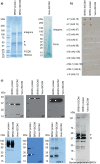Characterization of an experimental vaccine for bovine respiratory syncytial virus
- PMID: 24828093
- PMCID: PMC4097437
- DOI: 10.1128/CVI.00162-14
Characterization of an experimental vaccine for bovine respiratory syncytial virus
Abstract
Bovine respiratory syncytial virus (BRSV) and human respiratory syncytial virus (HRSV) are major causes of respiratory disease in calves and children, respectively, and are priorities for vaccine development. We previously demonstrated that an experimental vaccine, BRSV-immunostimulating complex (ISCOM), is effective in calves with maternal antibodies. The present study focuses on the antigenic characterization of this vaccine for the design of new-generation subunit vaccines. The results of our study confirmed the presence of membrane glycoprotein (G), fusion glycoprotein (F), and nucleoprotein (N) proteins in the ISCOMs, and this knowledge was extended by the identification of matrix (M), M2-1, phosphoprotein (P), small hydrophobic protein (SH) and of cellular membrane proteins, such as the integrins αVβ1, αVβ3, and α3β1. The quantity of the major protein F was 4- to 5-fold greater than that of N (∼77 μg versus ∼17 μg/calf dose), whereas G, M, M2-1, P, and SH were likely present in smaller amounts. The polymerase (L), M2-2, nonstructural 1 (NS1), and NS2 proteins were not detected, suggesting that they are not essential for protection. Sera from the BRSV-ISCOM-immunized calves contained high titers of IgG antibody specific for F, G, N, and SH. Antibody responses against M and P were not detected; however, this does not exclude their role in protective T-cell responses. The absence of immunopathological effects of the cellular proteins, such as integrins, needs to be further confirmed, and their possible contribution to adjuvant functions requires elucidation. This work suggests that a combination of several surface and internal proteins should be included in subunit RSV vaccines and identifies absent proteins as potential candidates for differentiating infected from vaccinated animals.
Copyright © 2014, American Society for Microbiology. All Rights Reserved.
Figures



Similar articles
-
Vaccine safety and efficacy evaluation of a recombinant bovine respiratory syncytial virus (BRSV) with deletion of the SH gene and subunit vaccines based on recombinant human RSV proteins: N-nanorings, P and M2-1, in calves with maternal antibodies.PLoS One. 2014 Jun 19;9(6):e100392. doi: 10.1371/journal.pone.0100392. eCollection 2014. PLoS One. 2014. PMID: 24945377 Free PMC article.
-
A new subunit vaccine based on nucleoprotein nanoparticles confers partial clinical and virological protection in calves against bovine respiratory syncytial virus.Vaccine. 2010 May 7;28(21):3722-34. doi: 10.1016/j.vaccine.2010.03.008. Epub 2010 Mar 20. Vaccine. 2010. PMID: 20307593 Free PMC article.
-
Bovine model of respiratory syncytial virus infection.Curr Top Microbiol Immunol. 2013;372:327-45. doi: 10.1007/978-3-642-38919-1_16. Curr Top Microbiol Immunol. 2013. PMID: 24362697
-
Immunology of bovine respiratory syncytial virus in calves.Mol Immunol. 2015 Jul;66(1):48-56. doi: 10.1016/j.molimm.2014.12.004. Epub 2014 Dec 29. Mol Immunol. 2015. PMID: 25553595 Review.
-
Human respiratory syncytial virus: pathogenesis, immune responses, and current vaccine approaches.Eur J Clin Microbiol Infect Dis. 2018 Oct;37(10):1817-1827. doi: 10.1007/s10096-018-3289-4. Epub 2018 Jun 6. Eur J Clin Microbiol Infect Dis. 2018. PMID: 29876771 Review.
Cited by
-
Biology of Infection and Disease Pathogenesis to Guide RSV Vaccine Development.Front Immunol. 2019 Jul 25;10:1675. doi: 10.3389/fimmu.2019.01675. eCollection 2019. Front Immunol. 2019. PMID: 31402910 Free PMC article. Review.
-
Use of Genomic Tools to Improve Cattle Health in the Context of Infectious Diseases.Front Genet. 2016 Mar 7;7:30. doi: 10.3389/fgene.2016.00030. eCollection 2016. Front Genet. 2016. PMID: 27014337 Free PMC article. Review.
-
Vaccine safety and efficacy evaluation of a recombinant bovine respiratory syncytial virus (BRSV) with deletion of the SH gene and subunit vaccines based on recombinant human RSV proteins: N-nanorings, P and M2-1, in calves with maternal antibodies.PLoS One. 2014 Jun 19;9(6):e100392. doi: 10.1371/journal.pone.0100392. eCollection 2014. PLoS One. 2014. PMID: 24945377 Free PMC article.
-
Proteome analysis of bronchoalveolar lavage from calves infected with bovine respiratory syncytial virus-Insights in pathogenesis and perspectives for new treatments.PLoS One. 2017 Oct 16;12(10):e0186594. doi: 10.1371/journal.pone.0186594. eCollection 2017. PLoS One. 2017. PMID: 29036182 Free PMC article.
-
Transplacental Antibody Transfer of Respiratory Syncytial Virus Specific IgG in Non-Human Primate Mother-Infant Pairs.Pathogens. 2021 Nov 5;10(11):1441. doi: 10.3390/pathogens10111441. Pathogens. 2021. PMID: 34832599 Free PMC article.
References
-
- Kimman TG, Westenbrink F, Straver PJ. 1989. Priming for local and systemic antibody memory responses to bovine respiratory syncytial virus: effect of amount of virus, virus replication, route of administration and maternal antibodies. Vet. Immunol. Immunopathol. 22:145–160. 10.1016/0165-2427(89)90057-3 - DOI - PubMed
Publication types
MeSH terms
Substances
Grants and funding
LinkOut - more resources
Full Text Sources
Other Literature Sources
Medical

